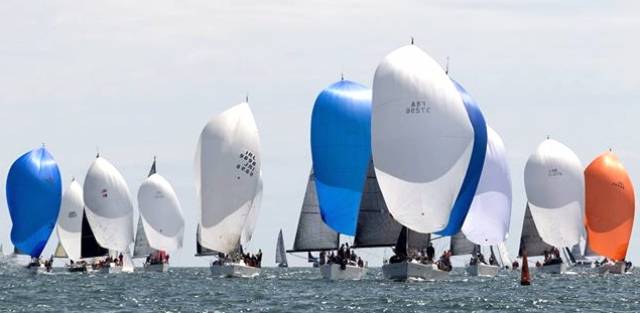In this week of meteorological mayhem exacerbated by an unsettling international political atmosphere, a reassuring and heartening mood of warm optimism was provided by getting together with Don O’Dowd, Chairman of the Organising Committee for Volvo Dun Laoghaire Regatta 2019 writes W M Nixon
The idea was to find out more about this year’s staging of a unique biennial event and to learn more of the background to a man who is the very essence of Dun Laoghaire’s remarkable reputation for the efficient administration of top sailing events and initiatives.
The long southern shore of Dublin Bay is unusual in that, once you’ve put the entrance to Dublin Port astern, the only significant recreational boating access to the sea between the inner Bay and Bray in North County Wicklow is to be found at Dun Laoghaire.
For sure, there are little harbours at Bulloch and Coliemore and two or three other places with open landing facilities. But the basic fact is that virtually all of the recreational maritime energy of South Dublin - one of the most affluent regions in Europe - is channelled through this one decidedly splendid artificial harbour.
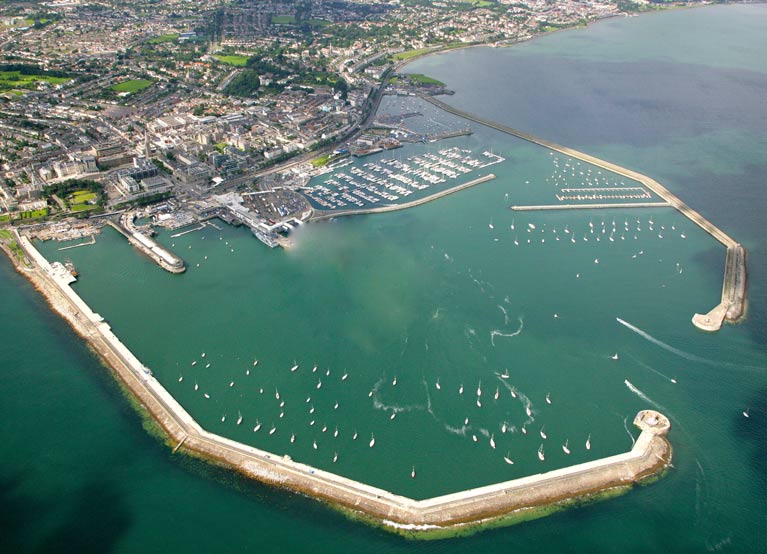 Conduit for sailing energy and innovation – Dun Laoghaire Harbour is the vital inter-connector between South Dublin’s affluent population and its sailing waters on Dublin Bay. As a result, the harbour clubs have long experience in creating events which attract many sailing visitors. Photo: Peter Barrow
Conduit for sailing energy and innovation – Dun Laoghaire Harbour is the vital inter-connector between South Dublin’s affluent population and its sailing waters on Dublin Bay. As a result, the harbour clubs have long experience in creating events which attract many sailing visitors. Photo: Peter Barrow
This results not only in sailing numbers which soar above all other centres in Ireland and on nearby coastlines but in a living and developing of sailing innovation and administration going back well over a hundred years. Some of the best brains and most abundant energies in all South Dublin have been active in this aspect of its sailing over the years, and the standards have become very high.
So agreeing to be Chairman of the biennial VDLR is not something to be undertaken lightly. And being Chairman for this year’s event brings its own extra challenges. For it says everything about the success of the Volvo Dun Laoghaire Regatta of 2017 that simply thinking of it transposes us back to warm summer evenings in July, when the waterfront clubs were buzzing with friendly crowds of shipmates and competitors at a host of post-racing events which exuded that happy mood which prevails when the day’s sailing has been good.
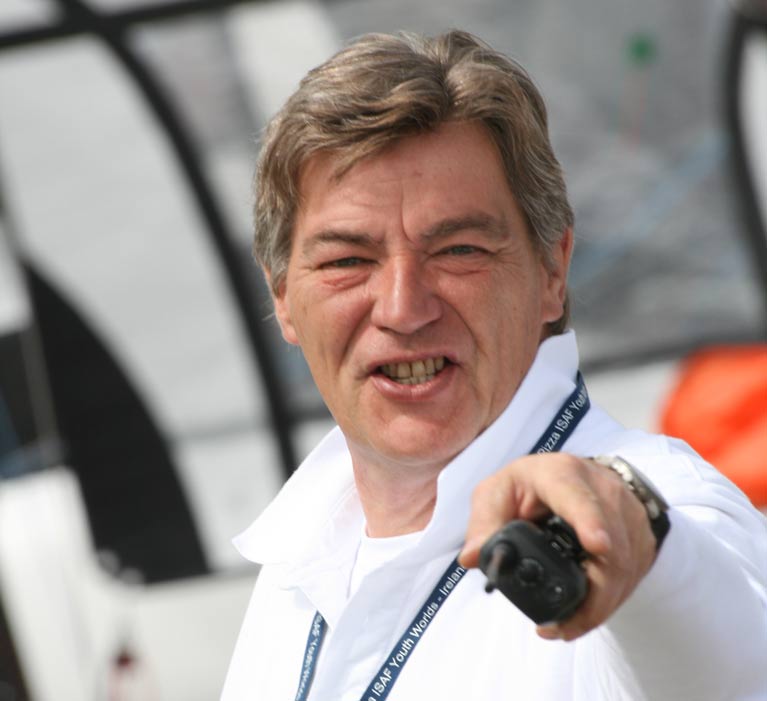 Administrative action – Don O’Dowd on the job at the 2012 ISAF Youth Worlds in Dublin Bay
Administrative action – Don O’Dowd on the job at the 2012 ISAF Youth Worlds in Dublin Bay
And there was a bonus with the regatta taking in its stride the extra challenge of celebrating the Bicentenary of Kingstown Harbour in a meaningful way which set exactly the right tone. This was boosted by the inauguration of a hugely successful classics and traditional division, and the result was as complete a regatta package as you could reasonably hope to experience.
Yet merely marking time and providing more of the same is not today’s Dun Laoghaire approach. Admittedly many of the modifications for 2019 will be just a matter of fine tuning on 2017’s success. But if there is a discernible line of thought for 2019, it is that while the emphasis remains on this being a fun regatta rather than a collection of major championships, good sport is actually the best fun racing people can have afloat, so the thinking is that those who want to up their game will be encouraged.
Partly this is because there’s a growing tendency to make use of the fact that the complete racing setup will be available at five centres out on the Bay to cater for what may be a total of as many as 39 classes. Some of these classes naturally get to thinking that if all this top level race-provision paraphernalia is out there on the Bay, why not optimise its easy availability and designate your class’s participation as being the Leinster Championship or even the National Championship?
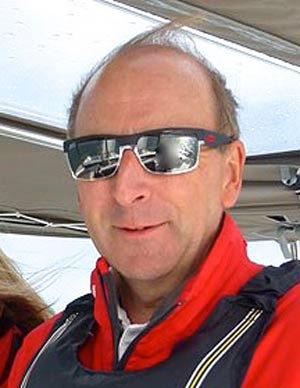 Race Director Con Murphy heads up a team of six Race Officers of International and Olympic standard. Photo: W M Nixon
Race Director Con Murphy heads up a team of six Race Officers of International and Olympic standard. Photo: W M Nixon
In past regattas classes as diverse as the IDRA 14s, the Wayfarers, and the GP 14s have done this, and for 2019 it has been stepped up a further gear with the Sigma 33 Class designating it as their special 40th Anniversary Championship and the RC35 class have made it a pillar of their Celtic Cup series between Scotland, Ireland and Wales, while the distinctive keelboats of the RS Elite Class have been allowed to designate the Volvo Dun Laoghaire Regatta as their UK National Championship.
Now that really is stretching the limits. But it’s something that Don O’Dowd is well-qualified to handle. Most if not all of the RS Elites in Ireland are based in the north, and a significant number are sailed by former International Dragon Sailors. Don O’Dowd was for many years at the very sharp end of International Dragon Racing, so he knows the kind of folk he’ll be dealing with in this unusual case, and with his years of experience already logged with running many major events, he sees how it can all be accommodated to give the RS Elites a worthwhile UK Nationals while stimulating rather than disturbing the ethos of the regatta.
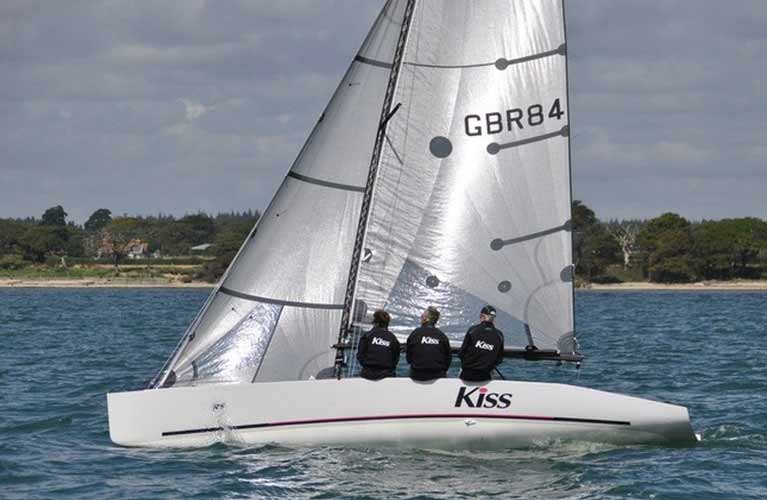 The RS Elite is designer Phil Morrison’s take on a miniature version of the America’s Cup keelboats of a previous generation.
The RS Elite is designer Phil Morrison’s take on a miniature version of the America’s Cup keelboats of a previous generation.
So who is he, this Don O’Dowd who comfortably bestrides so many important aspects of sailing? Well, if you wanted to set out to create the archetypal Dun Laoghaire sailor from scratch, you’d save yourself a lot of time and trouble simply by asking Don to step up to the plate, something he has been doing readily, willingly and effectively for our sport for many years.
His father Tom was a noted publican whose flagship establishment was The Old Punchbowl in Booterstown. While there were some family sailing links to Skerries and Clonrarf, the young Don’s memories are most clearly of a former International Dragon which Tom mostly just day-cruised, but occasionally raced with the cruisers from the National YC.
Living in Booterstown, O’Dowd Jnr had the daily trans-Liffey trek for schooling at Belvedere, where he took on board the rugby culture, but eased out of it after Junior Cup level. Meanwhile, his interest in sailing, while always there, has been inspired to fresh levels of enthusiasm by the International Mirror Europeans in 1966 at Wexford. The family had a holiday home in the sunny southeast, and one day his dad took him along to see the action and savour the atmosphere of this high-powered event at the legendary Wexford Harbour Boat & Tennis Club. Young Don was completely hooked by the whole experience, and still remembers his sense of awe in contemplating a Mirror dinghy with a graphite-finished bottom which was smoothed to a level of fast finish he’d never have imagined possible.
Back home, the new Junior Programme at the National Yacht Club was getting underway under the direction of Carmel Winkelmann and her colleagues (they’d a mighty Golden Jubilee celebration back in 2017) and Don O’Dowd was soon part of it with his own recently-acquired Mirror Dinghy.
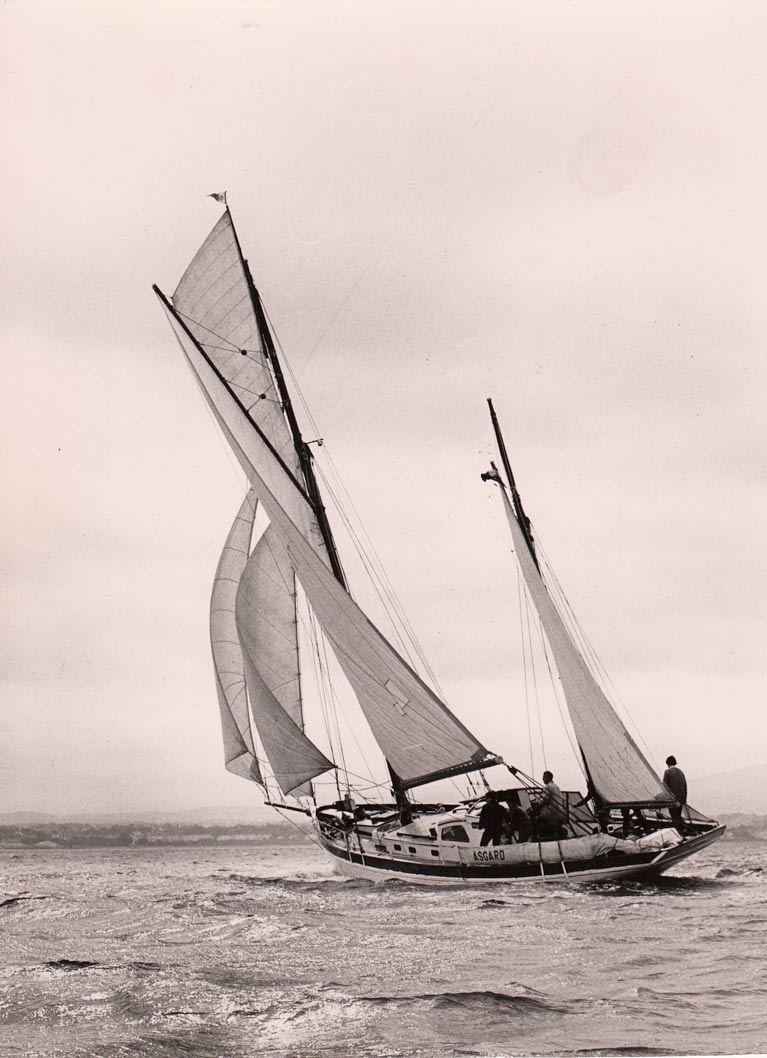 The original Asgard during her six years as Ireland’s sail training vessel between 1969 and 1975. The youthful Don O’Dowd was aboard her as a trainee when she voyaged to the Sailing Olympics at Kiel in Germany in 1972
The original Asgard during her six years as Ireland’s sail training vessel between 1969 and 1975. The youthful Don O’Dowd was aboard her as a trainee when she voyaged to the Sailing Olympics at Kiel in Germany in 1972
His sailing experiences during the 1970s were extraordinarily diverse. In addition to campaigning the Mirror, he was a trainee aboard the original Asgard when she was on the Tall Ships programme which brought her to the 1972 Olympic Games at Kiel on the Baltic in Germany. And then in 1976 when Asgard’s successor Creidne made her Transatlantic Voyage to join the Bicentennial Celebrations of the United States of America with the training ships of many nations in New York Harbour, O’Dowd was on her crew.
But in another sailing direction entirely, when the National Yacht Club decided to support the establishment of an International 420 Class, Don teamed up with John Lavery to campaign one of these new boats which were to transform the upper end of Irish sailing, and their partnership was very active and successful for four years.
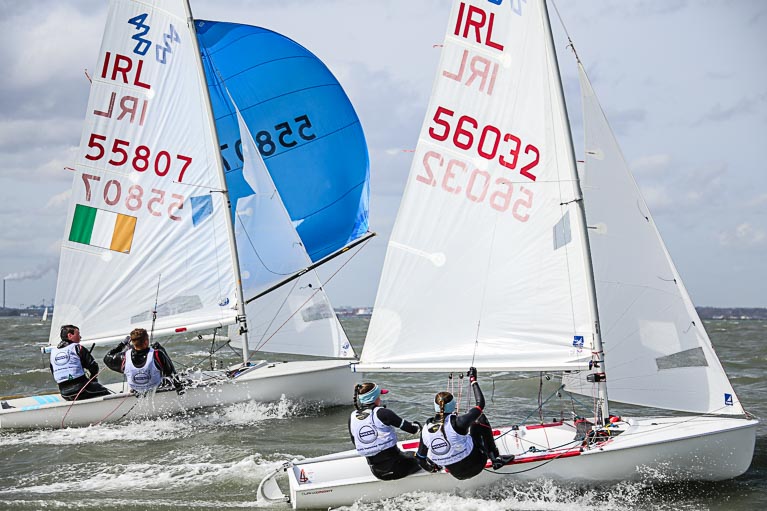 The International 420 getting into its stride. For four years, Don O’Dowd and John Lavery sailed together in this top junior class as it developed at the National YC
The International 420 getting into its stride. For four years, Don O’Dowd and John Lavery sailed together in this top junior class as it developed at the National YC
Yet with all the energy of youth during the late 1970s, he also found himself drawn into the developing offshore racing scene, where pace-setter Jim Poole of the National YC had acquired the state-of-the-art Bruce Farr-designed Quarter Tonner which became very well known on the Irish Sea as Farrocious.
The determined and dedicated Poole was sailing with his regular crewman Eamon Crosbie, and for ISORA campaigning they added the likes of Brian Mathews, Brian McGrath and Don O’Dowd with the occasional addition of Paul Rothschild and Paul Burke, such that Farrocious became very well known for the simple reason that she won just about everything for which she was eligible.
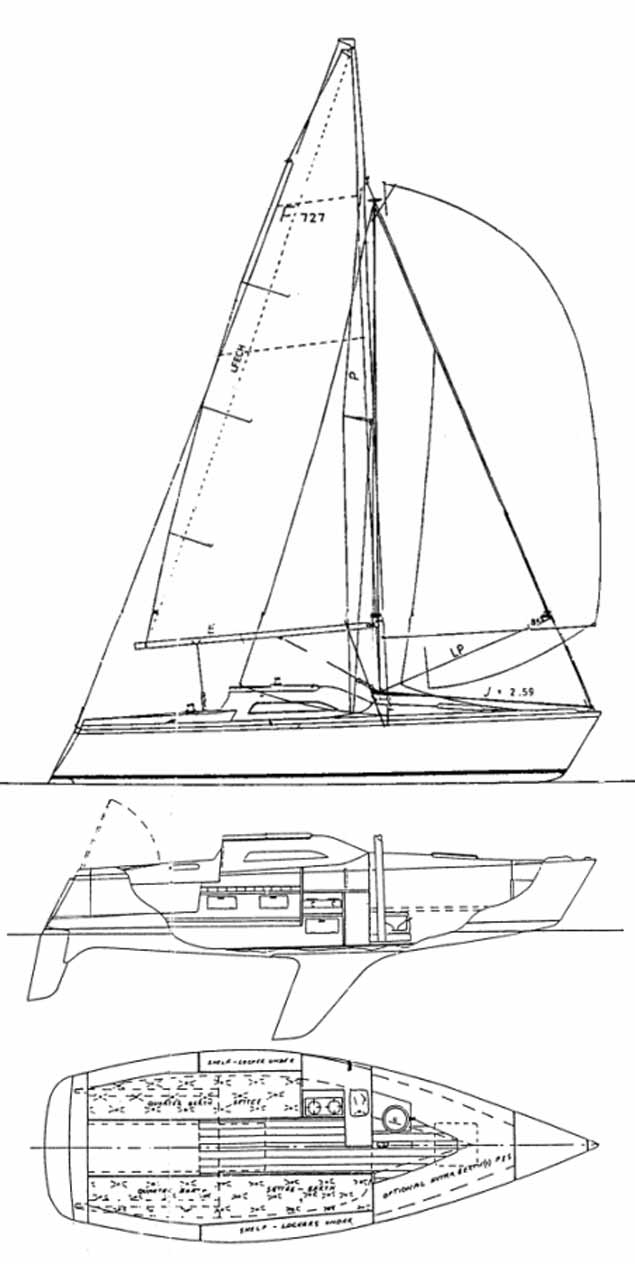 The plans of Jim Poole’s Bruce Farr-designed Quarter Tonner Farrocious. In the late 1970s when she won just about every ISORA trophy for which she was eligible, Don O’Dowd was a regular crewmember. She was capable of fantastic speeds offwind. “At 15 knots” Don recalls, “she started to hum – we knew she was in the groove”.
The plans of Jim Poole’s Bruce Farr-designed Quarter Tonner Farrocious. In the late 1970s when she won just about every ISORA trophy for which she was eligible, Don O’Dowd was a regular crewmember. She was capable of fantastic speeds offwind. “At 15 knots” Don recalls, “she started to hum – we knew she was in the groove”.
Meanwhile, shore life continued, and as his departure from Belvedere approached, Don felt drawn to marketing and took a diploma in it before testing a number of areas until he found himself working for the Bryan S Ryan organization dealing in office equipment and supplies, and reporting directly to Bryan’s brother, the great Ken Ryan. Ken was not only an ace in but was in the process of becoming a figure of significance in international sailing administration, going on to become the Secretary of the global International Finn Association.
Regular contacts with people of this calibre are bound to affect the outlook of keen young men working their way up the ladder in business and sailing, and in time Don O’Dowd’s natural capacity to run a complex business found him in a senior Irish role in the Velux Windows network, while his sailing had taken a new turn, or more accurately an additional interest.
During the 420 racing years (when the National Championships were always held at Mountshannon on Lough Derg) the Lavery/O’Dowd team had struck up a particular friendship with a rival crew, the brothers David and Alan McFarlane. With growing seniority, the 420 participation was inevitably closing towards its close by 1980, when Don O’Dowd and Alan McFarlane found they’d a shared enthusiasm for the possibilities of International Dragon racing. So they went into partnership with the acquisition of the wooden Dragon Ailsa from Geoffrey Ashenhurst.
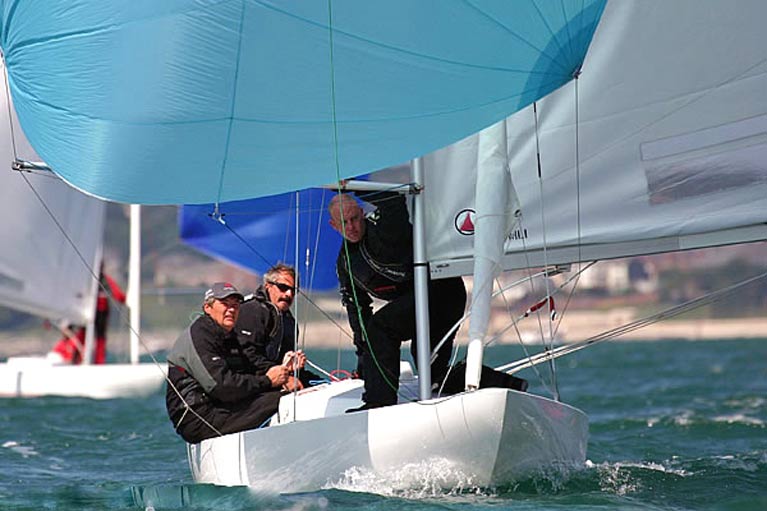 For more than twenty years, Don O’Dowd was a top International Dragon sailor – he is seen here trimming the spinnaker for Andrew Craig on Chimaera. Photo: Fiona Brown
For more than twenty years, Don O’Dowd was a top International Dragon sailor – he is seen here trimming the spinnaker for Andrew Craig on Chimaera. Photo: Fiona Brown
Thus they got to know Mick Cotter, who in those days was Dragon Racing Incarnate. He’d updated the wooden Tarasque at his home workshop, and when it became painfully obvious that Ailsa needed something similar, as Mick had spare space in his workshop he suggested the partners move Ailsa in alongside his boat and more or less replicate what he’d done with Tarasque.
It was the forging of another link in Don O’Dowd’s remarkable network of special friendships. For when - after a few years of great sailing with Ailsa - Alan McFarlane regretfully announced that a young man couldn’t afford to be both married and continue as a partner in an actively-campaigned Dragon, as he was about to get married Ailsa was sold, and Don O’Dowd moved aboard Mick Cotter’s succession of top-level International Dragons as the skipper’s right-hand man during what was to become a Golden Age for the Irish Dragon class.
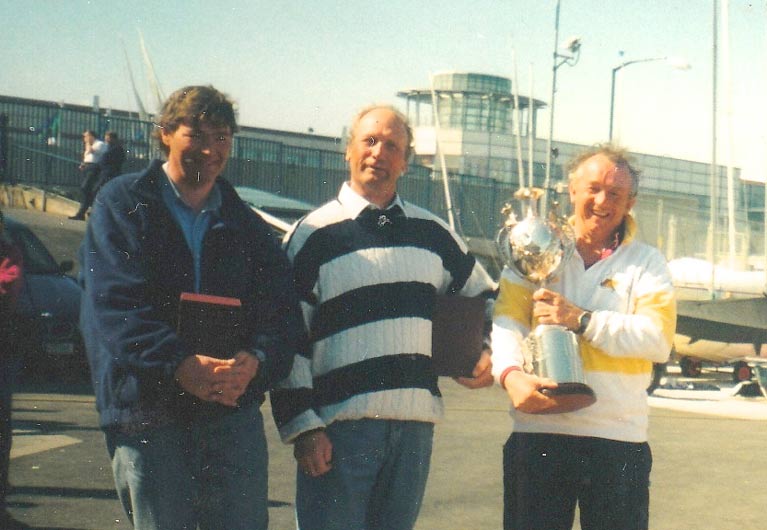 A special moment of success – Whisper wins Irish Dragon Championship 1998 at Royal St George YC with (left to right) Don O’Dowd, Paul Ricard Hoj Jensen and skipper Mick Cotter
A special moment of success – Whisper wins Irish Dragon Championship 1998 at Royal St George YC with (left to right) Don O’Dowd, Paul Ricard Hoj Jensen and skipper Mick Cotter
They won titles a-plenty including two Irish Nationals, but in addition there was the Southern European Circuit, a series of ferociously-contested regattas which started in Palma and concluded at Douarnenez in Brittany, an incredible cat’s cradle of logistics, sport and parties between high-end boats so identical that after one Douarnenez event, a certain Irish sailor was well on the road home when he found he was towing the wrong boat…..
It was a crazy pace, but back home Don O’Dowd’s life was following more regular paths, with his career in Velux going on to have an international dimension and the establishment of the top level Rationel brand in Ireland, and meanwhile he’d become engaged to Helen Burke, whose father was a former Irish Rugby International player, but they were happy with the proposed plans for the wedding celebrations to take place in the National Yacht Club.
Unfortunately, the National suffered a major fire as the great day approached, but Mick Cotter stepped into the breach by arranging that the wedding reception be held in his club, the Royal St George, where Don O’Dowd was already a regular. By the time the National was restored, the O’Dowd administrative talents and enthusiasm had been spotted by the likes of Brian Craig and Gary Treacy in the George, and somehow or other he has been a Royal St George sailor ever since, although like all on the VDLR Committee, he is at home and welcome in all four Dun Laoghaire clubs.
But there was much to do before the VDLR came over the horizon, for in the 1990s the Royal St George was emerging as a prodigious pace-setter both in Junior Training and in attracting major international events to Dun Laoghaire. With his two sons Jonathan and Matthew showing real sailing ability and interest, Don found himself teaming up with Gary Treacy and Peter O’Reilly to organise a major Winter Training Programme at RStGYC in 1998-99, with numbers well into the hundreds.
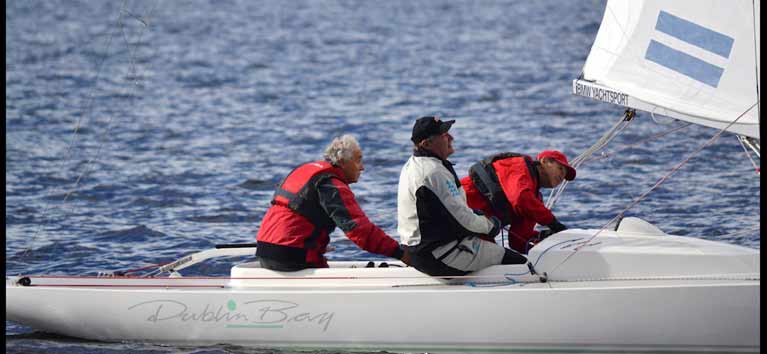 Project partners afloat and ashore – Gary Treacy and Don O’Dowd much absorbed in Dragon racing. Yet they also found the time to inaugurate intense RStGYC training programmes for the Mirror Class in concert Peter O’Reilly of the Optimists
Project partners afloat and ashore – Gary Treacy and Don O’Dowd much absorbed in Dragon racing. Yet they also found the time to inaugurate intense RStGYC training programmes for the Mirror Class in concert Peter O’Reilly of the Optimists
And all this at a time when the Dragon campaigning was at its height at home and abroad – with Mick Cotter’s Whisper so often overseas, it had been special to win the East Coast championship at Dun Laoghaire in 1992, but all the icing was on the cake in 1998 when they won the Irish Nationals at Royal St George.
On the junior side, in those days the Mirror Class was huge in Ireland and Don had both a family and a national interest, such that by the late 1990s, he found himself President of the Class Association with the vision to optimize the potential of the many young sailors coming through the ranks.
He and Gary Treacy felt that several promising juniors were being held back by poor quality Mirror dinghies, so they commissioned ace boatbuilder Edwin Brennan of Dun Laoghaire to build six Mirrors of top standard. The Mirror Worlds of 2001 were scheduled for Howth and already showed signs of attracting a record fleet, but Don O’Dowd and others in the Mirror administration were well aware that Ireland’s chances would be greatly improved with a solid backing for frustrated talent to get into the new boats in time for them to be fully tuned.
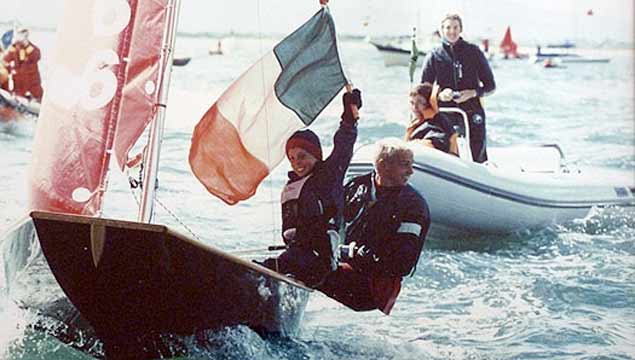 Job done. Peter Bayly and William Atkinson win the Mirror Worlds for Ireland at Howth in 2001
Job done. Peter Bayly and William Atkinson win the Mirror Worlds for Ireland at Howth in 2001
A particular case in point was Peter Bayly of Lough Derg YC, who was so disappointed in some of his own more recent showings that he was reportedly on the verge of giving up Mirror racing altogether. But Don and his team cajoled Bayly into one of the new boats, gave him every support and encouragement to realize his potential, and the reward for everyone came in 2001 when Peter Bayly - crewed by William Atkinson - won the 2001 Worlds for Ireland.
For the O’Dowd family, the Mirror sailing highlight came in 2003 when Jonathan – aged 16 – and Matthew – aged 11 – came for just one year within the right age cohort to compete together, and it turned out to perfection with them winning the Irish Nationals in Sligo.
It was typical of the pace with which the family were living the sailing life at the time that although their mother Helen was there in full support, their father with his above average height, long reach, general dexterity and many sailing skills was so much in demand in the Dragon fleet that he was down in Kinsale taking part in a major championship. But the mood of euphoria was such that Helen and the boys drove from Sligo to Kinsale for a joint celebration of the newly won trophy.
2003 marked something of a turning point, or at least a change of course, for with the Irish economy starting to soar, anyone with a genuine ability to run things well and a willingness to serve on specialist committees and similar bodies was much in demand, and Don O’Dowd was very much one of those people.
The business was expanding with modern headquarters in Sandyford, yet the family lived in Merrion and still do – he was and is a “reverse commuter”, which is no bad way to be. As for sailing, his main allegiance was still with the Dragons, but with Mick Cotter spreading his wings into larger craft Don found himself sailing – and frequently to success – with Gary Treacy and Andrew Craig.
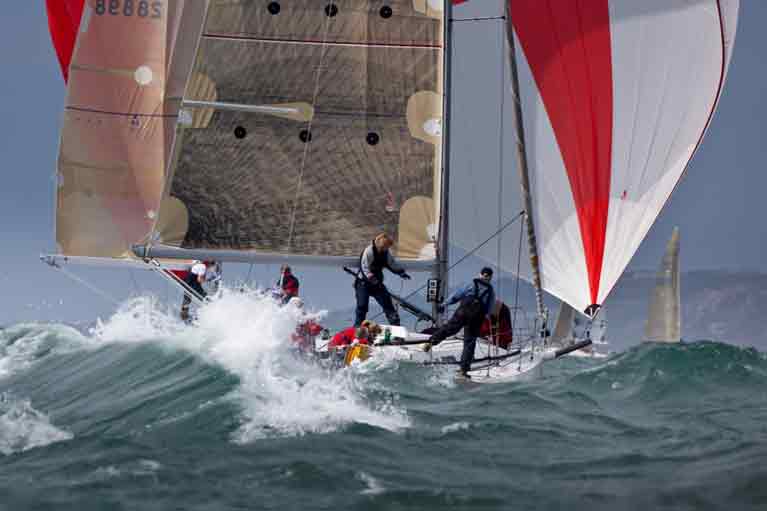 As the Irish economy surged in the Celtic Tiger years, the number of major international events in Dublin Bay increased. The biennial Volvo Dun Laoghaire Regatta was introduced in 2005, and immediately became a pillar event of the Irish sailing calendar – this is the J/109s getting into their stride in a good breeze of wind in 2011’s edition. Photo: VDLR
As the Irish economy surged in the Celtic Tiger years, the number of major international events in Dublin Bay increased. The biennial Volvo Dun Laoghaire Regatta was introduced in 2005, and immediately became a pillar event of the Irish sailing calendar – this is the J/109s getting into their stride in a good breeze of wind in 2011’s edition. Photo: VDLR
But inexorably he was drawn ever further into sailing administration, both of clubs and events. He’d already been the Irish Sailing Association “Volunteer of the Year” in 2003, and then he was Rear Commodore (Sailing) of the Royal St George YC in 2011-13. But these outward manifestations were only part of a pattern which included running the 420 Europeans in 2004 for the Royal St George with such efficiency that in time he found himself being drawn into the ultimate nuclear power unit, a tiny but far-reaching ideas and action factory known simply as Major Events, made up of Brian Craig and Don O’Dowd, with Ciara Dowling to provide structure for their thinking.
It was thinking which needed to be extremely clear-headed and very determined, for although they’d successfully staged the Star Europeans in 2009, in 2010 at the ISAF Conference in Barcelona they’d secured the ISAF Youth Worlds for Dun Laoghaire in 2012, and by the time the event actually happened, the Irish economy had fallen off a cliff, and it took nerves of steel to run such an outstandingly successful mega-event.
“Major Events” was of course an exclusively RStGYC unit, but by the early years of the 21st Century there was a gathering movement for Dun Laoghaire to stage a biennial blockbuster event, which eventually became the Volvo Dun Laoghaire Regatta promoted by all four clubs. Despite the extremely bumpy economic ride which the country has experienced since, the VDLR has become one of the real pillar events of Irish sailing, and since its inauguration in 2005, there have been five chairmen: Brian Craig (2005 & 2007); Phil Smith (2009); Adam Winkelmann (2011 & 2013); Tim Goodbody (2015 & 2017) and now Don O’Dowd (2019).
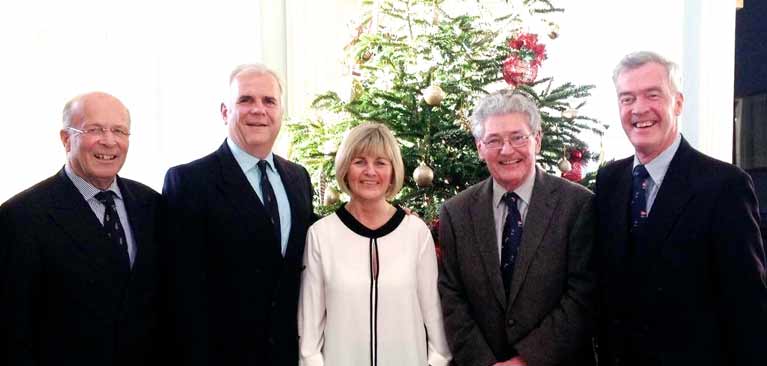 The Volvo Dun Laoghaire Regatta Chairmen with Executive Secretary Ciara Dowling are (left to right) Tim Goodbody (2015 & 2017), Adam Winkelmann (2011 & 2013), Ciara Dowling, Phil Smith (2009) and Brian Craig (2005 & 2007)
The Volvo Dun Laoghaire Regatta Chairmen with Executive Secretary Ciara Dowling are (left to right) Tim Goodbody (2015 & 2017), Adam Winkelmann (2011 & 2013), Ciara Dowling, Phil Smith (2009) and Brian Craig (2005 & 2007)
Continuity has been provided though Con Murphy being Race Director since the regatta was inaugurated, while the unflappable Ciara Dowling has been a source of reassurance to everyone through being Executive Secretary & Regatta Co-ordinator from the get-go. The pace of the management style for the VDLR 2019 is typified by a routine 0830hrs phone and email exchange every weekday morning between Ciara and Don to see where the emphasis of the day’s administrative work will be while looking ahead to the next stages in running such a major event.
Don O’Dowd had so many things on his plate until around 2015 that it wasn’t until then that he was approached to be on the VDLR Committee itself, with the view of taking over as Chairman in the fullness of time. His years of experience in sailing administration stand to everyone’s benefit, but as he admits himself, at 63 he is no longer quite the agile big fellah of top end Dragon racing that he used to be. In fact, for the past season or two, he has found extremely good sport with Colm O’Brien in the Jeanneau 39 Spirit in the White Sails Division, where he’s amused to note that every so often he finds himself in close competition with other former Dragon hotshots.
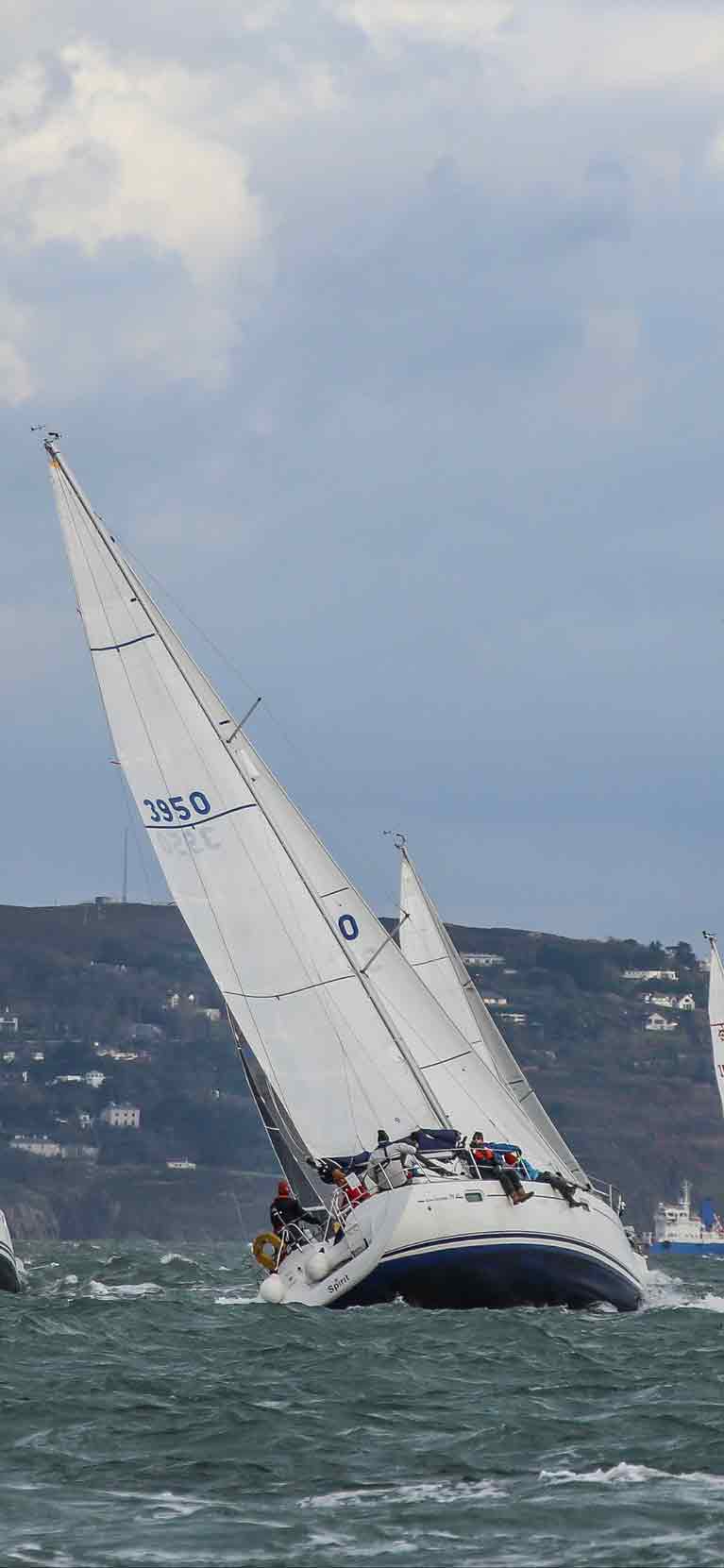 Colm O’Brien’s Jeanneau 39 Spirit racing in the White Sails Division. In a continuing sailing career which has ranged over 420 racing, ocean voyaging, hotshot offshore contests and top level Dragon competition, Don O’Dowd now finds it great sport to get the best possible performance out of a comfortable cruiser-racer.
Colm O’Brien’s Jeanneau 39 Spirit racing in the White Sails Division. In a continuing sailing career which has ranged over 420 racing, ocean voyaging, hotshot offshore contests and top level Dragon competition, Don O’Dowd now finds it great sport to get the best possible performance out of a comfortable cruiser-racer.
But as for the demands of being the Chairman of the Organising Committee for this most extraordinary regatta which relies on the support of volunteers of the highest calibre, his mantra is for improvement and quality rather than quantity. Though he may have the services of Race Officers of the experience and ability of Con Murphy, Jack Roy, Bill O’Hara, David Lovegrove, Peter Crowley and Harry Gallagher afloat, while on the waterfront he has the support of Sailing Managers like Mark McGibney, Ronan Adams and Olivier Prouveur, nevertheless he reckons that 2017’s regatta with 488 entries “was near enough optimum boat numbers”.
Yet here we are, entries already at 275, and it’s only March 16th with Early Bird entries running until March 31st. Either way, it’s a good time to have a steady, experienced and popular hand on the VDLR 2019 helm.
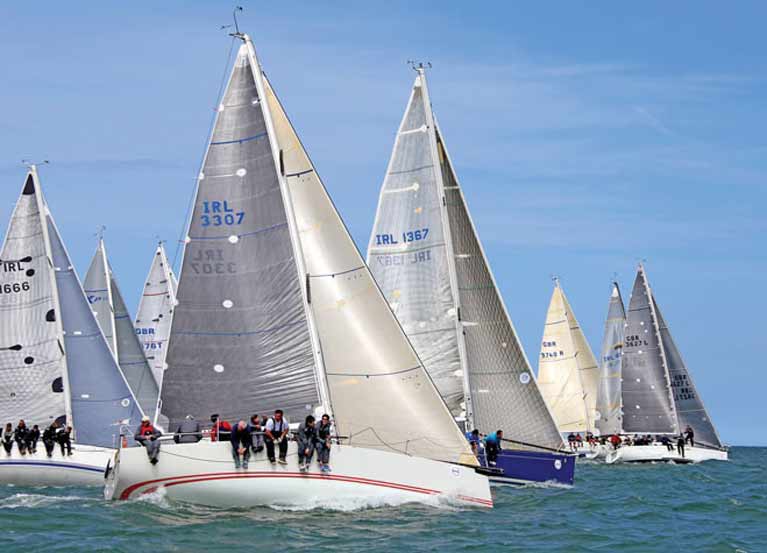 A clean start in a perfect sailing breeze – everyone’s hopes for the VDLR 2019. Photo: Afloat.ie/David O’Brien
A clean start in a perfect sailing breeze – everyone’s hopes for the VDLR 2019. Photo: Afloat.ie/David O’Brien




























